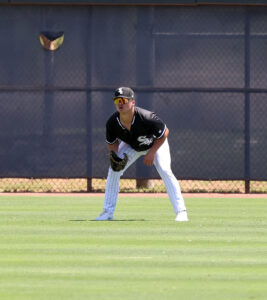Going Deep with Alex Destino
I’m guessing anyone reading this has spent more than a few times in a batter’s box staring down a pitcher. I’m also guessing that most of you did it at a low level before a pitcher had a complete set of pitches. Before you had to wonder if the next offering was going to be a curve or a slider, much less a nasty changeup.
Most of you walked up to the plate, waited for the pitcher to throw, sized it up, and if it looked good, took a rip. A few of you were lucky enough to make contact.
If that sounds relatable, my conversation with Alex Destino attempts to draw you into the professional batter’s box. You’ll get a sense of what goes through a hitters mind at the dish, why certain matchups are more difficult than others, and how to practice hitting specific pitches. If you’ve already made it that far, maybe you’ll pick up something useful.
The Lefty vs. Lefty Matchup
“In general, not many guys in baseball are going to say they want to face a lefty over a righty. In college, 80% of starters are right handed. In pro ball, that holds true. I see a lot more righties than I see lefties. It’s a comfort thing — that’s what I see more of,” Destino told FutureSox in a phone interview.
“In a left-on-left matchup, you have to really lock in. All of their breaking balls are going away from you. This year when I’ve gone through struggles, guys like to come in hard under my hands and then work away with soft. It comes down to selling out and finding my approach and sticking to it. I don’t think I’ve done terrible against lefties this year, but there are always ways to improve against those guys.”
“A good slider is a tough pitch, an up and down curveball is a little easier to see. Sliders to the outer third of the plate, to just off the plate, are probably the toughest ones I see against lefties.”
Hitting the Changeup
“Good changeups – any pitcher that can throw one and keep a good fastball down, then come back off of it with both their breaking ball and changeup are tough to hit. Anytime a pitcher can complement their fastball with an off speed pitch, they’re going to give the hitter a hard time,” said Destino.
“Good changeups are very hard to recognize. Obviously, off a four- seam fastball, a lot of guys throw a four-seam changeup which comes out of the hand with the same type of spin. It just kinda slows down. Toward the end, some guys will give it away and flick their wrist over. Those are the ones that are a little easier to see. If a guy is working down in the zone and comes off that with a changeup down in the zone, that is one of the hardest pitches in baseball to pick up,” said Destino.
Practice Time
“We’ll do a hard/soft round in the cage. The coach will flip me one that’s firm representing the fastball. Then he’ll flip me one that’s floating; that’ll make me get into my low position and wait on it. It makes me more comfortable with the uncomfortable. If my timing is off on a changeup that gives me the ability to stay on my legs and hit that ball.”
Don’t Overthink It
“I really like scouting reports. I don’t like to look too deep into them. It can mentally impact my approach. If I’m going to the plate and a new guy comes in, I’ll ask [the hitting coach] what’s his go-to secondary pitch against a lefty. I don’t look at the percentage of counts he throws it in, or how often he throws a curveball on a hitters count. I just like to know what his go-to pitch is against me. If it’s not going to be a fastball, if he prefers a change up or the breaking ball — I just go from there with it.”
“A bullpen guy is where you see it the most – a spike in the percentage. So, say, we have a guy that’s a mid-90s righty. He’ll come in and you see he’s going throw his fastball a lot. If the hitting coach tells me he’s got a big breaking ball – he’s got a sharp slider. If it sticks out – something crazy like if he gets me in a 1-2 count or 0-2 count, he goes to his slider. If the tendency is over 40%, that’s pretty eye-opening. That sometimes can help me out. I can keep that in the back of my head and maybe sit on a pitch if I get that count,” said Destino.
“I try not to get too locked in, but there were a couple of times, where I completely sold out on a pitch, and I got it. That’s a great feeling too.”
Beating the Shift
“One team does a power lefty shift on me. I’ll get a few shifts where the third baseman goes not quite to where the shortstop would play, but five feet to his left. The shortstop will slide behind second base. I try to keep the same approach if it’s a drastic one, and shortstop is wide open. If it’s a team that is trying to go soft away, I’ll shift my approach and try to hit a ground ball right at shortstop. If I can hit fastballs that way, I feel pretty confident that I can hit breaking balls up the middle or to the pull side.”
Grab a Bat
You’ve been schooled. Now, pick up a bat and get in the cage. There are still a couple of months until Spring Training.
Want to know right away when we publish a new article? Type your email address in the box on the right-side bar (or at the bottom, if on a mobile device) and click the “create subscription” button. Our list is completely spam free, and you can opt out at any time. Also, consider supporting FutureSox on Patreon! You can get early access to special articles and Patreon-only posts, in addition to more benefits you can read about here.




